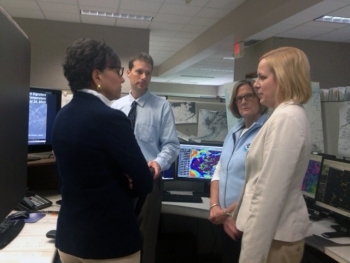Aug222014
Posted at 12:15 PM
From daily weather forecasts, severe storm warnings and climate monitoring, to fisheries management, coastal restoration and supporting marine commerce, the National Oceanic and Atmospheric Administration’s (NOAA) products and services support economic vitality and affect more than one-third of America’s gross domestic product. NOAA maintains a presence in every state, and Alaska is no exception.
Secretary Pritzker visited Anchorage this week to see first-hand how Commerce helps Alaska stay “open for business” and provides critical environmental intelligence to citizens, planners, emergency managers and other decision makers in the region. During her first trip to Alaska in her official capacity, Secretary Pritzker was joined by NOAA Administrator Dr. Kathryn Sullivan.
Together, Secretary Pritzker and Dr. Sullivan are highlighting one of the key pillars of the Department’s “Open for Business Agenda” – the importance of unlocking more of the tremendous data collected every day and using it to help businesses and communities around the country.
Secretary Pritzker visited the Alaska Weather, Water and Ice Center which is the National Weather Service’s (NWS) main operations center in Anchorage. The Center is also among the largest consolidated NWS operations centers containing four specialized operational units. No other forecasting operation is positioned to deliver such integrated information services – from marine weather and sea ice to hydrology to public and aviation forecasts – making it incredibly beneficial to Alaskan and Arctic decision makers.
In addition to the NWS Center and various forecast offices, NOAA facilities in the state include four marine laboratories, an atmospheric observatory, and a satellite command data acquisition station.
While touring and learning about the various forecasting desks in Anchorage, Secretary Pritzker also had the opportunity to recognize Hydrologist in Charge at the River Forecasting Center, Robin Radlein, who is retiring in October after 38 years of service to the agency.
Later in the day, Secretary Pritzker and Dr. Sullivan met with about 75 NOAA employees to learn more about their work and thank them for their service. NOAA team members had the opportunity to provide their perspectives and discuss Alaska-specific issues with the Secretary and Dr. Sullivan.
In Alaska, the prioritization of data is inextricably linked to the emphasis the Department is placing on providing communities and businesses with the information, products and services they need to prepare for and prosper in a changing environment. Examples of Commerce data and research that helps the people of Alaska includes:
- NOAA’s fisheries research and management programs, which are both vital to promoting sustainable use and conservation in light of a changing climate. Fishing is a $5.8 billion industry in Alaska, and supports 100,000 jobs. Fishery-related tourism also brings in more than $300 million annually for the state;
- NOAA’s sea ice research which strengthens the forecasts of both ice and weather conditions, and helps build a better understanding of the direct links between sea ice and climate change;
- NOAA essential decision support services that provide regional decision makers with forecasts and warnings for events like extratropical storms, tsunamis, floods, droughts, and volcanic ash;
- Important NOAA services like mapping and charting, for coastal communities which improves safe Arctic maritime access and prepares communities for intensifying weather.
Building on existing tools and services, the Commerce Department and NOAA help Alaskan communities sustain economic growth and create jobs by providing products and services to adequately prepare for the possible wide-ranging effects of a changing climate.




